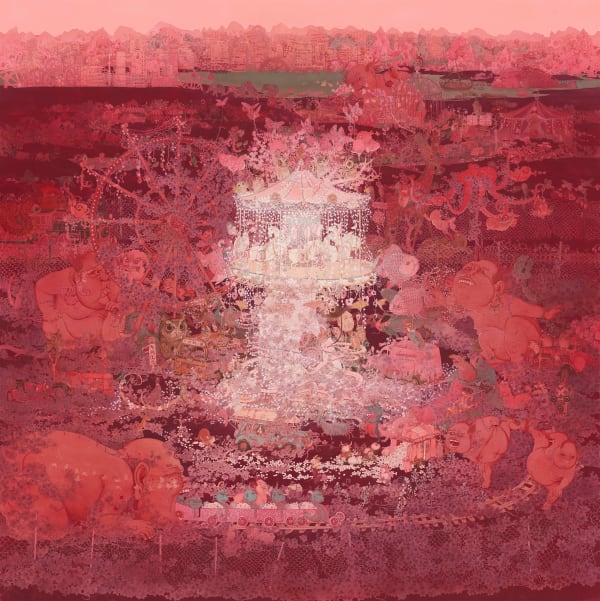Bian Kai: Conjuring Realities
INKstudio is proud to present "Bian Kai: Conjuring Realities," the first solo exhibition for the Liaoning-born visual artist Bian Kai (b. 1981). In his contemporary painting practice, Bian Kai draws extensively upon China's rich mythological, philosophical and religious narrative traditions referencing classical texts—such as the Warring States Era Classic of Mountains and Seas, the Six Dynasties Peach Blossom Spring and the Tang Dynasty Buddhist Canon A Biography of The Tripiṭaka Master of the Great Ci'en Monastery—to render modern parables for our contemporary times. Using the various historical, heavy-polychrome, visual-narrative languages employed in Buddhist and Taoist temple murals, Tibetan Buddhist thangkas and Chinese imperial court painting, Bian Kai visually reconstitutes the mythological, religious content of his source material but never in a direct retelling or portrayal of the canonical story or image. Rather, in what he describes as painting as "performance" yan 演 or art(ifice), he transforms the canonical telling to conjure a "truth" zhen 真 for his audience that is both transcendent and personal.
In "Bian Kai: Conjuring Realities", INKstudio will be exhibiting the artist's representative masterworks from the last ten years including (on the first floor) Next Stop: Peach Blossom Spring 下一站桃花源 (2024) from his "City" series; the monumental screen The Unbound Journey 逍遥 (2022) from his "Wandering Far and Wide" series; and its companion work Cosmography of the Primordial 山 · 海 (2020) from his "Mountains and Seas" series; and (on the third floor) The Shore of Enlightenment 慧岸 (2018) from his "Religions" series; and the left-incomplete, six-panel work Peach Blossom Spring: Arcadia as Unfinishable 未完成的桃花源 (2016) from his "Peach Blossom Spring" series.
The exhibition will be up for over ten weeks and will function as an open research workshop where Bian Kai will collaborate with graduate researchers Nancy CHU from Stanford University and Chuxin ZHANG from the Institute of Fine Arts, New York University, the curator Deng Feng from the National Art Museum of China, and others to excavate and record the many layers of historical, philosophical, religious, literary and mythological content resident in his extraordinary conjured realities.
Asian Polychrome Painting
“Bian Kai: Conjuring Realities” follows “Kang Chunhui: Observing My Distant Self” and “Lao Tongli’s Iconology of Life” as the third in a series of curatorial projects focused on the early trans-national, heavy-polychrome narrative painting pictorial language that spread from India to Central Asia, Southeast Asia, China, Korean and Japan with the dissemination of Buddhism and later returned to Central Asia, Persia and the Middle East in the form of the Persian, Moghul and Ottoman miniature. This visual art has taken modern and contemporary form through the art reforms of Meiji-era Japan—the Nihonga Superflat movement led by contemporary Nihonga-trained artists such as Takashi Murakami (b. 1962, Tokyo) —through the postcolonial, post-modern revival of the Persian/South Asian miniature by contemporary South Asian artists such as Shahzia Sikander (b. 1969, Lahore) and Imran Qureshi (b. 1972, Hyderabad), through the post Reform and Opening-Up revival of imperial court painting by artists such as Xu Lei (b. 1962, Nantong) and Hao Liang (b. 1983, Chengdu) and through the contemporary thangka-inspired paintings of Tibetan artists such as Tenzing Rigdol (b. 1982, Kathmandu) and Gonkar Gyatso (b. 1961, Lhasa).







